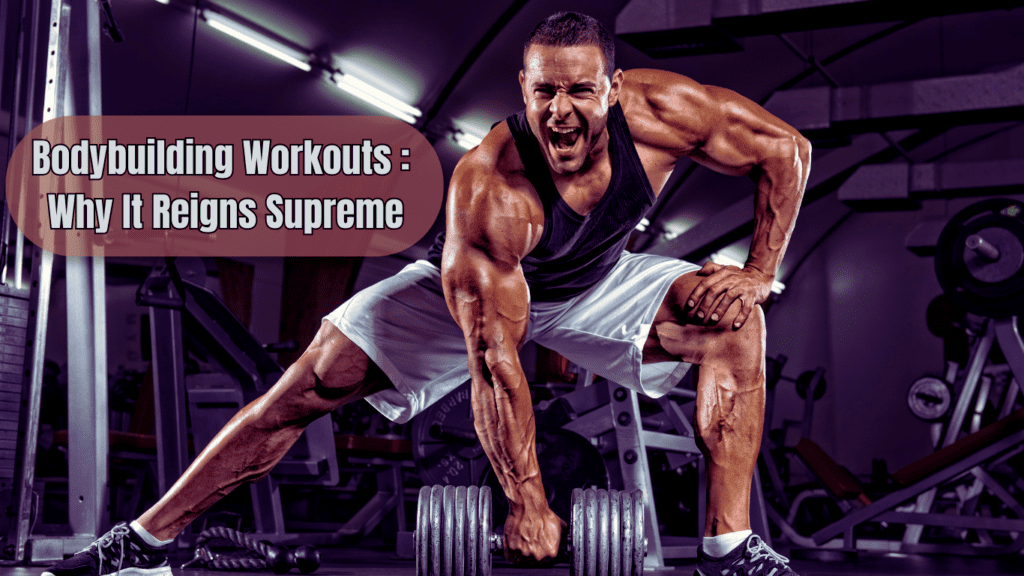Getting Started: The Best Calisthenics Workout for Beginners Explained
In this article, we will guide you through the best calisthenics workout for beginners, offering practical tips and essential exercises to kickstart your fitness journey.
When starting a new fitness routine, the choices can be overwhelming. With so many types of workouts out there, it’s easy to feel lost or uncertain about where to begin. Among these options, calisthenics stands out as a highly effective and accessible form of exercise, particularly for beginners.
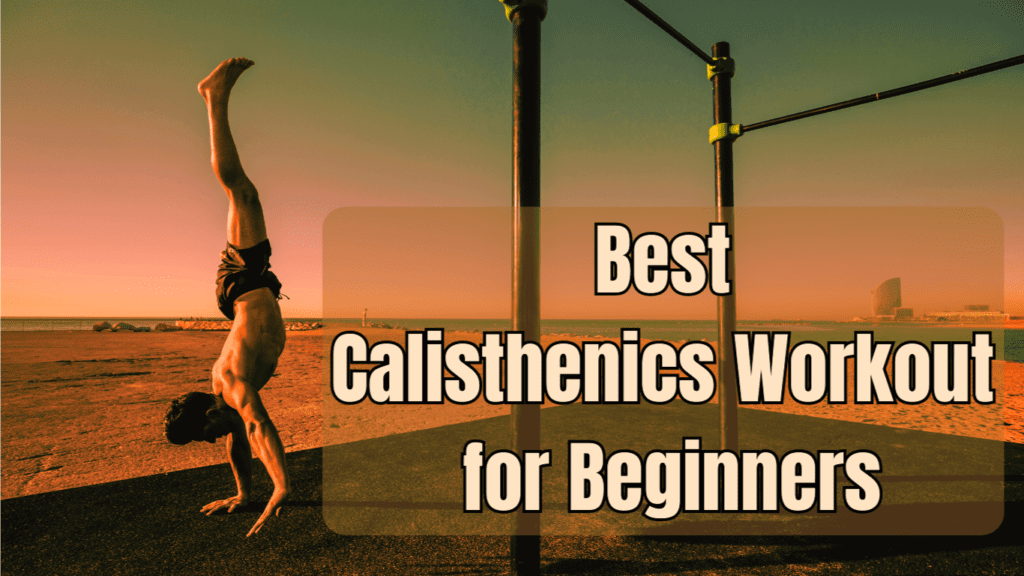
What is Calisthenics?
Calisthenics is essentially a workout routine that uses your body weight as resistance. This form of exercise includes basic movements such as push-ups, squats, and lunges. The term “calisthenics” comes from the Greek words “kallos” meaning beauty and “sthenos” meaning strength. Historically, it was practiced by ancient Greeks to improve physical conditioning and has been a cornerstone of fitness ever since.
What makes calisthenics an excellent choice for beginners? For one, it simplifies the process of getting started with exercise. You don’t need access to a gym or a lot of equipment. In fact, the beauty of calisthenics lies in its minimalistic approach—your own body is the primary tool you’ll use. This makes it a fantastic option if you’re just stepping into the world of fitness or if you’re looking for a cost-effective way to stay in shape.
Benefits of Calisthenics for Beginners
So why should you consider calisthenics as the best calisthenics workout for beginners? For starters, it offers a multitude of benefits that cater perfectly to those just starting out. One of the primary advantages is the development of strength, flexibility, and endurance. By performing exercises that use your own body weight, you’re engaging multiple muscle groups simultaneously. This not only helps build overall strength but also enhances your flexibility and stamina.
Subscribe And Get Our Free E-Book:Unlocking The Power Of Nutrition-Supplements, Substitutes, and Superfoods!
Moreover, calisthenics is incredibly accessible. Since you don’t need specialized equipment or a gym membership, it removes many of the barriers that might otherwise prevent someone from working out. This can be particularly appealing if you’re someone who feels intimidated by complex machinery or gym environments.
Who Should Try Calisthenics?
Calisthenics is versatile and suitable for virtually everyone, regardless of age or fitness level. It’s particularly beneficial for those who are new to working out and may be hesitant to dive into more advanced or equipment-heavy routines. Whether you’re a teenager looking to build strength, an adult aiming to get fit, or a senior wanting to maintain mobility, calisthenics can be adapted to meet your needs.
In the upcoming sections of this article, we’ll delve deeper into specific calisthenics exercises and how to structure a workout routine that aligns with your fitness goals. Stay tuned to discover the best calisthenics workout for beginners and how you can start incorporating these exercises into your daily routine.
Calories Burned in 30 Minutes of Common Calisthenics Exercises Chart:
| Exercise | Calories Burned (120 lbs) | Calories Burned (155 lbs) | Calories Burned (185 lbs) |
|---|---|---|---|
| Push-ups | 135 | 167 | 200 |
| Squats | 150 | 190 | 230 |
| Lunges | 144 | 180 | 216 |
| Planks | 90 | 112 | 135 |
| Pull-ups | 180 | 223 | 266 |
| Dips | 150 | 186 | 222 |
Key Insights:
- This chart gives beginners a clear idea of the caloric impact of their workouts based on their weight.
- Highlights how effective bodyweight exercises are not just for strength but also for burning calories.
- Encourages readers to adjust exercise intensity and duration based on their fitness goals (whether they’re focusing on strength, endurance, or calorie burn).
Understanding the Basics of Calisthenics
Understanding the basics of calisthenics is crucial for anyone beginning their fitness journey. As we explore the best calisthenics workout for beginners, it’s essential to grasp foundational concepts that will set the stage for effective and safe training.
Body Mechanics and Alignment
When diving into calisthenics, proper form is the cornerstone of a successful workout. Proper alignment and technique not only maximize the benefits of each exercise but also significantly reduce the risk of injury. Each movement in calisthenics relies on the principle that your body should be aligned and positioned correctly to perform effectively and safely.
One key concept in calisthenics is core engagement. Your core includes muscles in your abdomen, lower back, and pelvis, and it plays a vital role in maintaining balance and stability during exercises. Engaging your core ensures that your spine is protected and your body is properly aligned, which is especially important in exercises like planks or push-ups. When your core is engaged, you create a solid base that allows other muscles to work more effectively.
Posture is another crucial element. Good posture means keeping your spine in a neutral position, avoiding excessive arching or rounding. Proper posture helps distribute the load evenly across your muscles and joints, preventing undue stress and strain. For example, during a squat, maintaining an upright torso with your shoulders back and your chest lifted helps you execute the movement correctly and protect your lower back.
Breath control also plays a significant role in calisthenics. Proper breathing helps maintain endurance and focus, and it ensures that your muscles receive adequate oxygen. For most exercises, inhale during the easier phase of the movement and exhale during the more strenuous part. For instance, during a push-up, you should inhale as you lower yourself and exhale as you push back up. This rhythm helps keep your body functioning optimally and supports your performance.
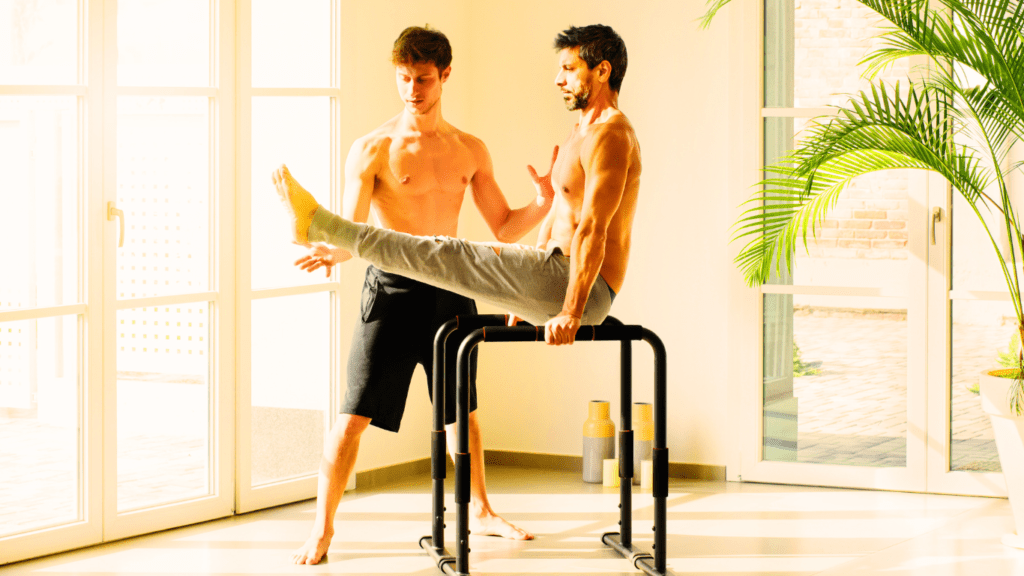
Progression vs. Perfection
As you start with the best calisthenics workout for beginners, it’s important to focus on gradual progression rather than immediate perfection. Calisthenics offers a wide range of exercises that can be modified to match your current fitness level. Beginning with simpler movements and gradually advancing to more complex ones is key to building strength, flexibility, and confidence.
Start with basic exercises such as push-ups, squats, and lunges. These fundamental movements help build a solid foundation and prepare your body for more challenging routines. For instance, if a standard push-up is too difficult, you can begin with knee push-ups or wall push-ups. As you gain strength and proficiency, you can progress to more demanding variations.
Gradual progression involves incrementally increasing the difficulty of your workouts. For example, once you’re comfortable with basic squats, you can advance to single-leg squats or incorporate weights. This approach not only enhances your overall fitness but also helps you avoid the frustration and potential injury that can come from attempting advanced exercises too soon.
It’s also important to listen to your body and adjust your workouts as needed. If you find yourself struggling with a particular exercise, it’s perfectly fine to modify it or take a step back to focus on the basics. The goal is to build a strong foundation and continuously challenge yourself while avoiding burnout or injury.
In addition to progression in individual exercises, consider the overall structure of your workouts. Variety is beneficial, as it ensures that different muscle groups are targeted and reduces the risk of overuse injuries. Incorporating a mix of exercises such as pull-ups, dips, and planks alongside your primary movements can provide a well-rounded workout routine.
As you become more experienced, you might start integrating more complex exercises into your routine. These can include muscle-ups, handstands, and advanced bodyweight movements that require a higher level of strength and skill. However, remember that these advanced exercises should only be attempted after mastering the basics and ensuring that your body is prepared for the added challenges.
Another aspect of progression involves recovery and rest. Your muscles need time to repair and grow stronger after workouts, so incorporating rest days and proper recovery strategies into your routine is essential. This can include activities like stretching, foam rolling, and adequate hydration and nutrition. Recovery is a critical component of any fitness regimen, and it supports your overall progress.
Understanding the basics of calisthenics is crucial for anyone new to this form of exercise. Focusing on proper body mechanics, including core engagement, posture, and breath control, will help you perform exercises safely and effectively. Emphasizing gradual progression rather than seeking immediate perfection will enable you to build a solid foundation and advance steadily in your fitness journey. By starting with the best calisthenics workout for beginners and progressively challenging yourself, you’ll be well on your way to achieving your fitness goals.
Warm-Up Routine for Calisthenics Workouts
When it comes to starting the best calisthenics workout for beginners, one crucial step that should never be overlooked is the warm-up. Warming up is not just a preliminary activity; it’s a vital part of any exercise routine that can significantly impact your performance and safety.
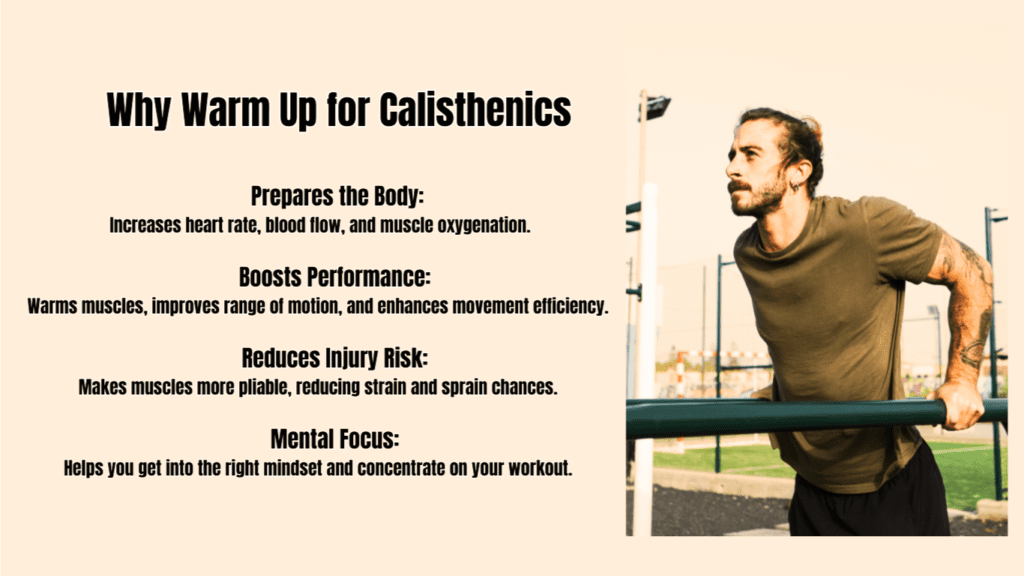
Importance of Warming Up
Warming up is essential for several reasons. Firstly, it prepares your body for the physical demands of exercise by gradually increasing your heart rate and blood flow to your muscles. This increased circulation helps to ensure that your muscles are adequately oxygenated and ready for the workout ahead. By raising your body temperature, warming up also makes your muscles more pliable and reduces the risk of strains and sprains.
Secondly, warming up helps to enhance your performance. When your muscles are warm and your joints are lubricated, you’re able to move more freely and with greater efficiency. This means you can perform each exercise with better form and range of motion, which can lead to more effective workouts and improved results.
Finally, a proper warm-up can also have a mental benefit. It provides an opportunity to mentally prepare for the workout, focus your attention, and get into the right mindset. This mental preparation is just as important as the physical aspect of warming up, as it helps you to approach your exercises with greater concentration and motivation.
Dynamic Stretches and Mobility Exercises
Dynamic stretches and mobility exercises are excellent components of a warm-up routine, especially when preparing for the best calisthenics workout for beginners. Unlike static stretches, which involve holding a stretch for an extended period, dynamic stretches involve moving through a full range of motion, which better prepares your muscles and joints for the workout.
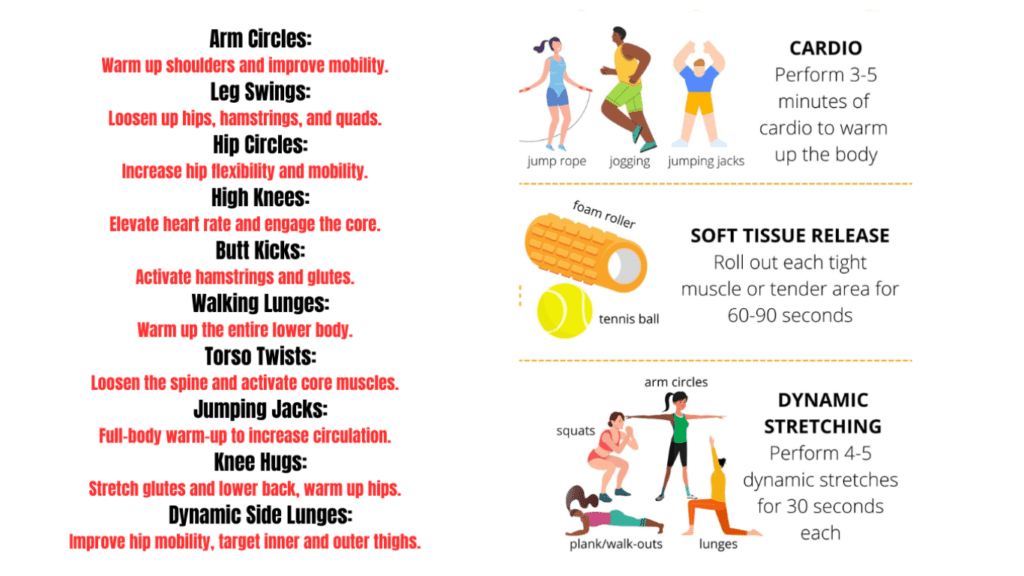
Here are some effective dynamic stretches and mobility exercises that target major muscle groups and help get your body ready for action:
1. Arm Circles
Arm circles are great for warming up the shoulders and upper arms. Stand with your feet shoulder-width apart, extend your arms out to the sides, and make small circles with your arms. Gradually increase the size of the circles and then reverse the direction. This exercise helps increase blood flow to the shoulder muscles and improves joint mobility.
2. Leg Swings
Leg swings help loosen up the hip flexors, hamstrings, and quadriceps. Stand next to a wall or support for balance. Swing one leg forward and backward in a controlled manner, gradually increasing the range of motion. Repeat with the other leg. This movement helps to prepare the hips and legs for dynamic exercises like squats and lunges.
3. Hip Circles
Hip circles are effective for improving hip mobility. Stand with your feet shoulder-width apart, place your hands on your hips, and make large circles with your hips, first in one direction and then in the other. This exercise helps to loosen up the hip joints and increase the flexibility of the surrounding muscles.
4. High Knees
High knees are an excellent way to get your heart rate up and warm up your lower body. While standing in place, lift one knee to hip level, then quickly switch to the other knee, as if running in place. This exercise activates the hip flexors, quadriceps, and calves while also engaging your core.
5. Butt Kicks
Butt kicks are another dynamic exercise that warms up the lower body, particularly the hamstrings and glutes. While jogging in place, kick your heels up towards your glutes. This movement helps increase circulation to the back of your legs and prepares them for more demanding exercises.
6. Walking Lunges
Walking lunges are fantastic for warming up the entire lower body. Take a step forward with one leg and lower your hips until both knees are bent at about a 90-degree angle. Push off with your back foot and step forward with the other leg into the next lunge. This exercise activates the quadriceps, hamstrings, and glutes while also stretching the hip flexors.
7. Torso Twists
Torso twists help to loosen up the spine and engage the core. Stand with your feet hip-width apart and gently rotate your torso from side to side, keeping your hips stable and your movements controlled. This exercise prepares your core and upper body for rotational movements and improves overall flexibility.
8. Jumping Jacks
Jumping jacks are a classic warm-up exercise that engages the entire body. Start by standing with your feet together and arms at your sides. Jump while spreading your legs and raising your arms overhead, then return to the starting position. This full-body exercise helps increase your heart rate and warms up multiple muscle groups simultaneously.
9. Knee Hugs
Knee hugs are effective for stretching the glutes and lower back while also warming up the hip flexors. While standing, lift one knee towards your chest and hug it with both hands. Hold for a moment, then switch legs. This exercise helps increase flexibility and prepares your lower body for more intensive movements.
10. Dynamic Side Lunges
Dynamic side lunges are excellent for working on hip mobility and warming up the inner and outer thighs. Step out to the side with one leg, bending that knee while keeping the other leg straight. Push off the bent leg to return to the starting position and repeat on the other side. This exercise helps prepare your hips and legs for lateral movements.
Incorporating these dynamic stretches and mobility exercises into your warm-up routine can help you get the most out of your best calisthenics workout for beginners. They not only prepare your body for the physical activity ahead but also contribute to overall better performance and injury prevention. By dedicating a few minutes to a thorough warm-up, you set yourself up for a more effective and enjoyable workout experience.
The Best Calisthenics Exercises for Beginners
When embarking on the journey with the best calisthenics workout for beginners, selecting the right exercises is crucial. These exercises form the core of your routine, helping you build strength, endurance, and overall fitness. In this section, we’ll dive into some essential calisthenics exercises, focusing on the upper body, core, lower body, and full body movements. We’ll also touch on the importance of a proper cool-down routine to wrap up your workout.
Upper Body Exercises
Push-Ups
Push-ups are a fundamental upper body exercise that targets the chest, shoulders, and triceps. They come in several variations that are suitable for different fitness levels.
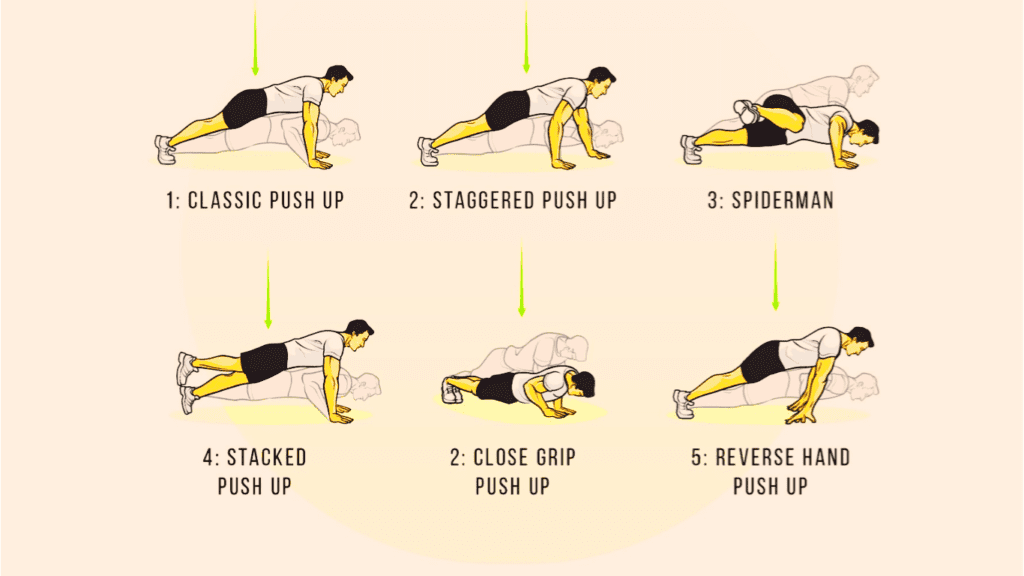
- Wall Push-Ups: Start by standing a few feet away from a wall. Place your hands on the wall at shoulder height and width. Lean in towards the wall, bending your elbows, then push back to the starting position. This variation is ideal for beginners as it reduces the load on the upper body.
- Knee Push-Ups: Begin in a plank position but with your knees on the ground. Lower your body towards the floor by bending your elbows, then push back up. This modification is a step towards performing standard push-ups and helps build the necessary strength.
- Standard Push-Ups: For a standard push-up, place your hands on the floor slightly wider than shoulder-width apart and keep your body in a straight line from head to heels. Lower your body until your chest nearly touches the ground, then push back up. It’s crucial to maintain proper form, keeping your elbows at about a 45-degree angle to avoid strain on your shoulders.
Common mistakes with push-ups include sagging hips, flaring elbows, and not lowering your body sufficiently. Focus on maintaining a straight body line and engaging your core throughout the movement.
Dips
Dips are excellent for working the triceps, shoulders, and chest. They can be performed using different equipment.
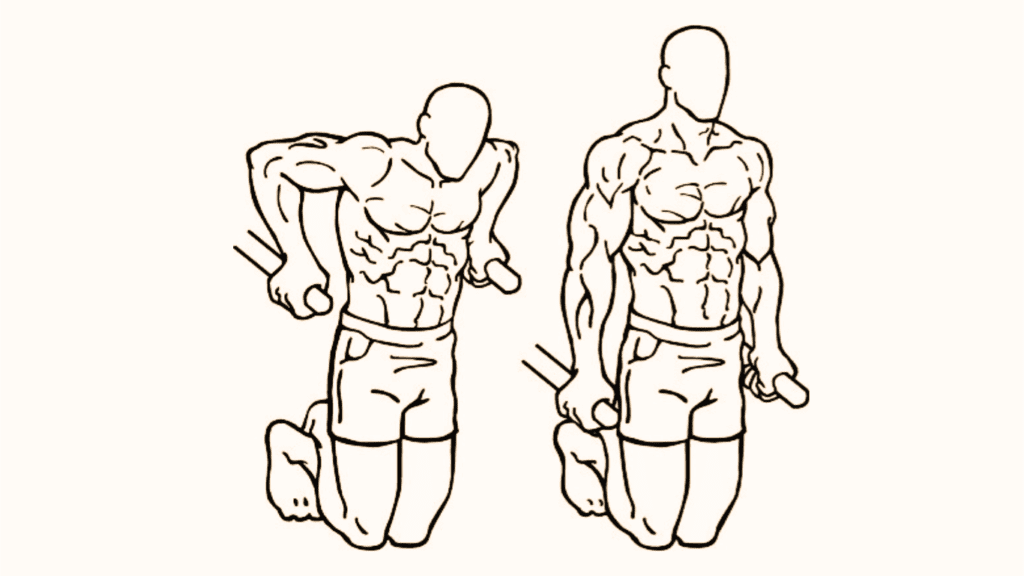
- Bench Dips: Sit on the edge of a bench with your hands beside you and your fingers pointing forward. Move your hips off the bench and lower your body by bending your elbows, then push back up. Bench dips are a good starting point for beginners.
- Parallel Bar Dips: If you have access to parallel bars, grip the bars and lift your body by extending your arms. Lower yourself until your upper arms are parallel to the ground, then push back up. This variation is more challenging and requires more strength.
Tips for executing dips safely include keeping your shoulders down and avoiding letting your elbows flare out too much. Focus on a controlled motion to prevent strain on your shoulders and wrists.
Core Exercises
Plank
The plank is a powerful exercise for building core strength and stability.
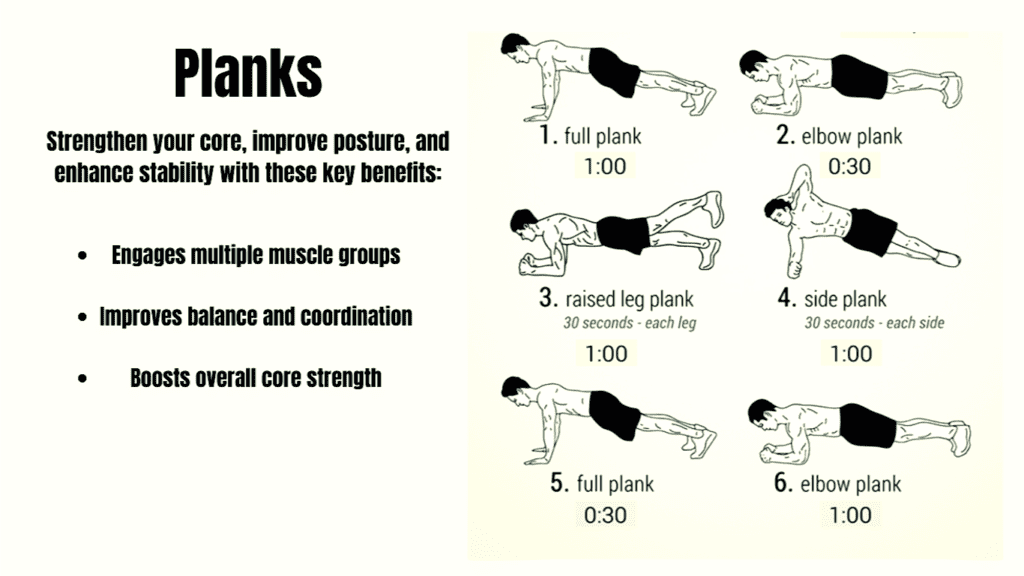
- Forearm Plank: Start on your forearms and toes, keeping your body in a straight line from head to heels. Hold this position while engaging your core.
- High Plank: Similar to the forearm plank, but on your hands instead of your forearms. This variation also engages the shoulders and chest.
- Side Plank: Lie on your side, propping yourself up on one elbow and keeping your body in a straight line. Hold this position to work the obliques and improve lateral core strength.
Maintaining a straight line is essential in all plank variations. Avoid letting your hips sag or rise too high. Engaging your core and keeping your body aligned will maximize the benefits and minimize the risk of injury.
Leg Raises
Leg raises are effective for targeting the lower abs.
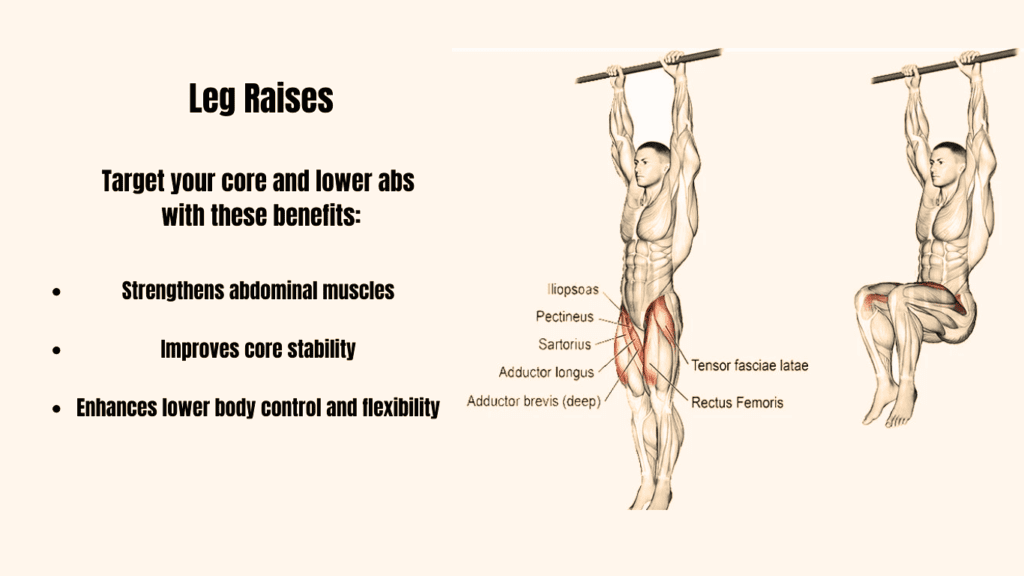
- Lying Leg Raises: Lie on your back with your legs straight and lift them towards the ceiling, keeping them together. Lower them back down without touching the ground. This exercise focuses on the lower abdominal muscles.
- Hanging Leg Raises: Using a pull-up bar, hang with your legs straight down and raise them towards your chest. This advanced variation adds a challenge and further engages the core.
Leg raises help target the lower abs, but proper form is crucial. Avoid swinging your legs and keep your movements controlled to ensure maximum effectiveness.
Lower Body Exercises
Squats
Squats are a fundamental exercise for building lower body strength.
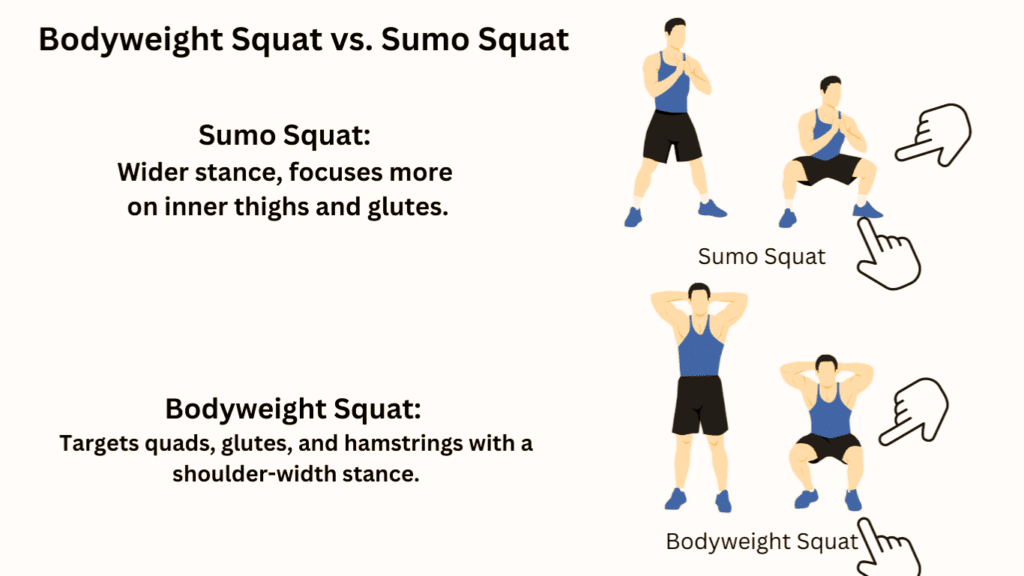
- Bodyweight Squats: Stand with your feet shoulder-width apart. Lower your body by bending your knees and hips, keeping your back straight and chest up. Push through your heels to return to the starting position.
- Sumo Squats: Stand with your feet wider than shoulder-width apart and toes pointed slightly outward. Perform the squat movement in the same way as the bodyweight squat. This variation targets the inner thighs and glutes more intensely.
Proper form is crucial for squats. Ensure your knees stay aligned with your toes and don’t extend past your toes. Engage your glutes as you rise to maintain balance and effectiveness.
Lunges
Lunges are great for targeting the quads, hamstrings, and glutes.
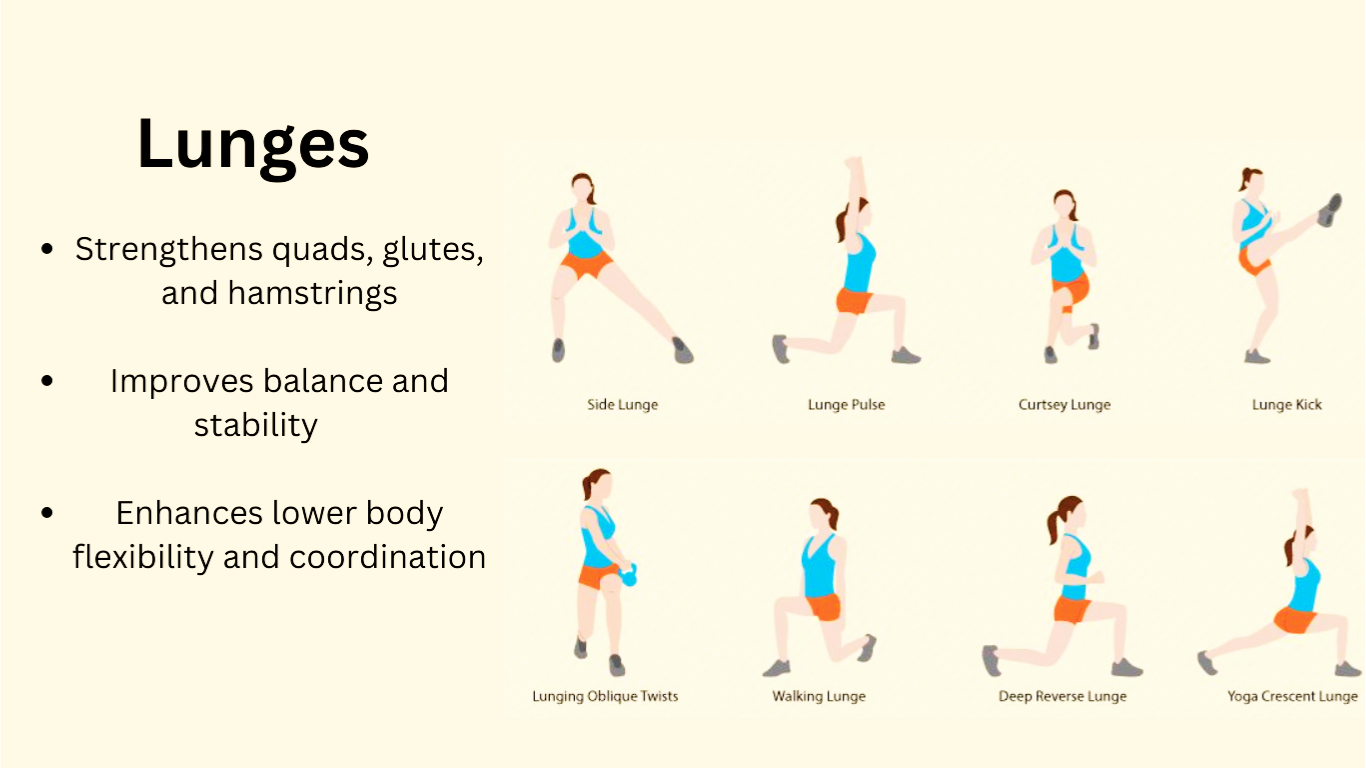
- Forward Lunges: Step forward with one leg and lower your hips until both knees are bent at approximately 90 degrees. Push back to the starting position and repeat with the other leg.
- Reverse Lunges: Step backward with one leg and lower your body until your front thigh is parallel to the ground. Return to the starting position and repeat on the other side.
Balancing and knee positioning are essential for lunges. Make sure your front knee stays over your ankle and doesn’t extend beyond your toes to avoid unnecessary stress on the knee joint.
Full Body Exercises
Burpees
Burpees are a full-body exercise that combines strength, cardio, and coordination.
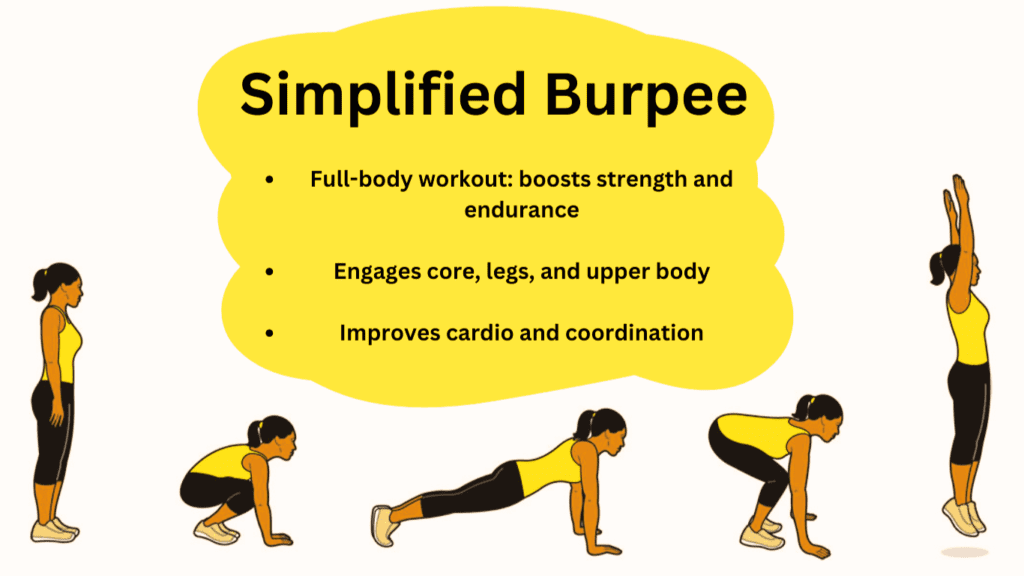
- Simplified Burpee: Start by standing with your feet shoulder-width apart. Bend your knees and place your hands on the floor, then step your feet back into a plank position. Step your feet back towards your hands, and stand up. For beginners, omitting the jump can make this exercise more manageable.
Burpees challenge your cardiovascular system while engaging multiple muscle groups. To perform them effectively, focus on smooth transitions between movements and maintain a steady pace.
Mountain Climbers
Mountain climbers are an excellent exercise for core strength and cardiovascular endurance.
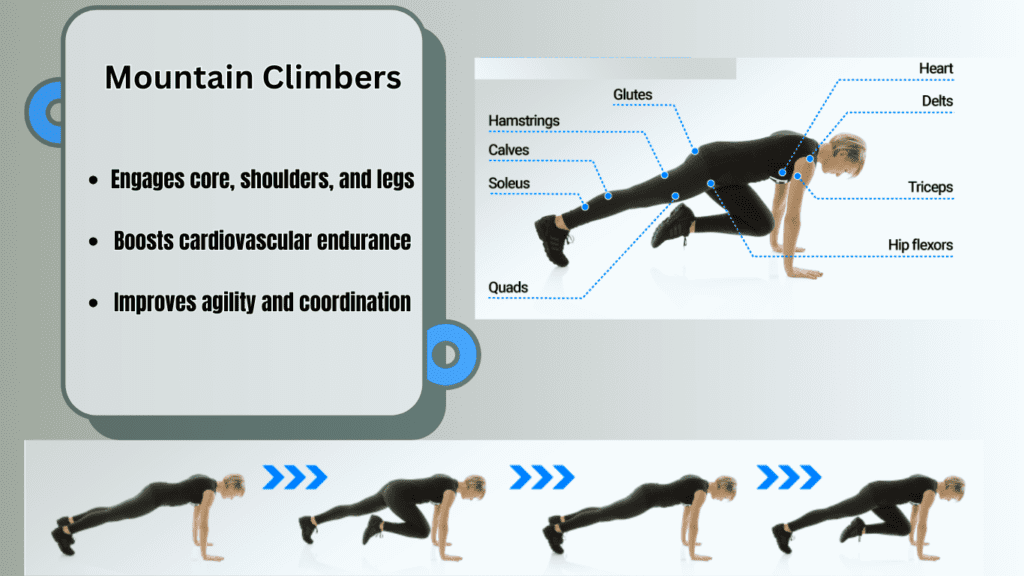
- Execution: Start in a high plank position with your hands under your shoulders. Bring one knee towards your chest, then switch legs in a running motion. This exercise engages your core and increases your heart rate.
Mountain climbers are effective for working the core and improving cardiovascular fitness. Keep your movements controlled and maintain a steady pace to maximize the benefits.
Muscle Groups Targeted by Beginner Calisthenics Exercises Chart:
| Exercise | Primary Muscle Groups | Secondary Muscle Groups |
|---|---|---|
| Push-Ups | Chest, Shoulders, Triceps | Core, Lower Back |
| Dips | Triceps, Shoulders, Chest | Forearms, Lower Back |
| Planks | Core (Abs, Obliques), Lower Back | Shoulders, Glutes |
| Leg Raises | Lower Abs | Hip Flexors, Lower Back |
| Squats | Quadriceps, Glutes, Hamstrings | Core, Calves |
| Lunges | Quadriceps, Hamstrings, Glutes | Calves, Core |
| Burpees | Full Body (Chest, Legs, Core, Shoulders) | Cardiovascular System, Triceps, Glutes |
| Mountain Climbers | Core, Shoulders, Chest, Legs | Cardiovascular System |
Key Insights:
- Push-ups and dips primarily work the upper body (chest, shoulders, triceps) while also engaging the core for stability.
- Planks and leg raises are core-centric exercises, with planks engaging a wider range of muscles for stabilization.
- Squats and lunges focus on the lower body but also require core stabilization, making them excellent for overall lower body strength.
- Burpees and mountain climbers are full-body exercises that not only build strength but also improve cardiovascular fitness.
Cool-Down Routine
After completing the best calisthenics workout for beginners, it’s important to cool down properly. Cooling down helps reduce muscle soreness, promotes recovery, and prevents stiffness.
Importance of Cooling Down: Cooling down gradually lowers your heart rate and helps your muscles relax. This transition from high-intensity exercise to a resting state can aid in reducing the risk of injury and improve overall recovery.
Static Stretches: Incorporate static stretches to target the muscles you worked during your workout. Hold each stretch for 20-30 seconds to help lengthen and relax the muscles. Focus on areas such as the hamstrings, quads, shoulders, and back.
Deep Breathing Exercises: Deep breathing helps to calm the nervous system and promote relaxation. Practice deep breathing by inhaling slowly through your nose, holding for a few seconds, and exhaling through your mouth. This can aid in lowering your heart rate and reducing exercise-induced stress.
By incorporating these exercises into your routine and following a proper cool-down, you’ll be well on your way to maximizing the benefits of the best calisthenics workout for beginners. Whether focusing on upper body, core, lower body, or full-body movements, each exercise plays a role in building a strong foundation for your fitness journey.
Creating a Beginner Calisthenics Workout Plan
Creating a solid beginner calisthenics workout plan is a key part of getting started with the best calisthenics workout for beginners. A structured approach not only helps you build strength and improve your fitness but also keeps you safe from injuries. In this section, we’ll explore how to set up your workouts, give you a sample weekly plan, and show you how to track your progress effectively.
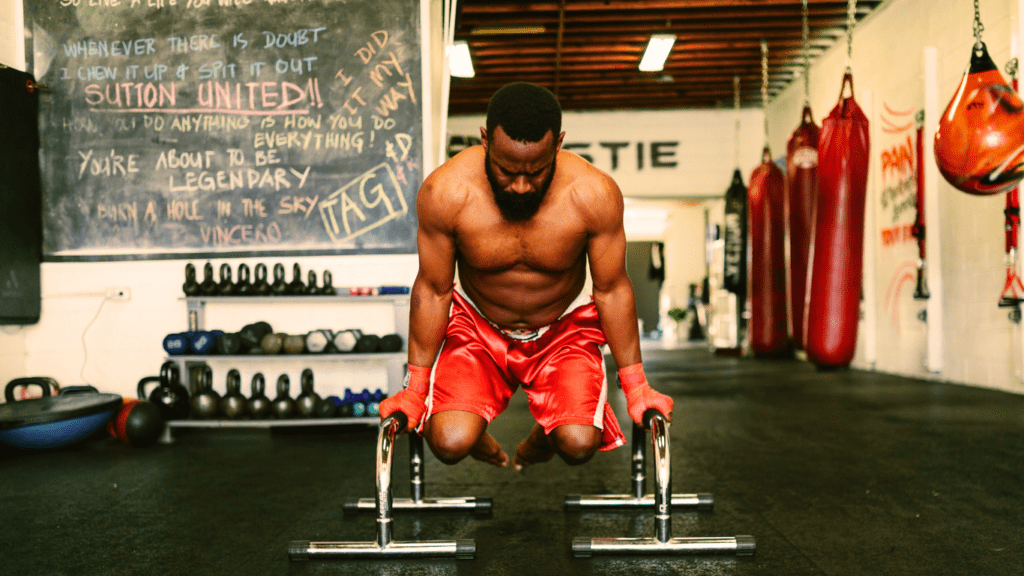
How to Structure Your Workouts
When setting up your workout plan, the goal is to create a balanced routine that covers all major muscle groups and incorporates various types of exercises. Here’s a straightforward approach to structuring your workouts:
Choosing Exercises: Start with fundamental exercises that target different parts of your body. For the best calisthenics workout for beginners, you’ll want to include exercises for your upper body, lower body, and core. Examples include push-ups for the upper body, squats for the lower body, and planks for the core. This variety ensures you’re not just focusing on one area but building overall strength.
Balancing Your Routine: Incorporate both push and pull exercises into your routine. Push exercises (like push-ups) focus on the chest, shoulders, and triceps, while pull exercises (like inverted rows) target the back and biceps. Including both types helps maintain muscular balance and avoids overuse injuries.
Another important element is to mix in core and lower body exercises. Core exercises (like planks) enhance stability and support your overall strength, while lower body exercises (like lunges) build foundational strength and mobility.
Sample Weekly Workout Plan
A weekly workout plan can guide you through the best calisthenics workout for beginners. Here’s a simple plan to get you started:
Monday: Upper Body & Core
- Warm-Up: 5 minutes of dynamic stretches (e.g., arm circles, high knees)
- Workout:
- Push-Ups: 3 sets of 10-12 reps
- Bench Dips: 3 sets of 8-10 reps
- Forearm Plank: 3 sets of 30 seconds
- Leg Raises: 3 sets of 10-12 reps
- Cool-Down: 5 minutes of static stretching (e.g., chest stretch, shoulder stretch)
Tuesday: Lower Body
- Warm-Up: 5 minutes of dynamic stretches (e.g., leg swings, hip circles)
- Workout:
- Bodyweight Squats: 3 sets of 12-15 reps
- Sumo Squats: 3 sets of 10-12 reps
- Forward Lunges: 3 sets of 10 reps per leg
- Cool-Down: 5 minutes of static stretching (e.g., quadriceps stretch, calf stretch)
Wednesday: Rest or Active Recovery
Engage in light activities like walking or gentle stretching to recover.
Thursday: Upper Body & Core
- Warm-Up: 5 minutes of dynamic stretches (e.g., arm circles, butt kicks)
- Workout:
- Knee Push-Ups: 3 sets of 10-12 reps
- Parallel Bar Dips: 3 sets of 6-8 reps
- High Plank: 3 sets of 30 seconds
- Hanging Leg Raises: 3 sets of 8-10 reps
- Cool-Down: 5 minutes of static stretching (e.g., triceps stretch, back stretch)
Friday: Lower Body
- Warm-Up: 5 minutes of dynamic stretches (e.g., side lunges, hip circles)
- Workout:
- Bodyweight Squats: 3 sets of 15 reps
- Reverse Lunges: 3 sets of 12 reps per leg
- Single-Leg Romanian Deadlifts: 3 sets of 10 reps per leg
- Cool-Down: 5 minutes of static stretching (e.g., hamstring stretch, groin stretch)
Saturday: Full Body
- Warm-Up: 5 minutes of dynamic stretches (e.g., jumping jacks, high knees)
- Workout:
- Burpees: 3 sets of 8-10 reps
- Mountain Climbers: 3 sets of 30 seconds
- Bodyweight Squats: 2 sets of 15 reps
- Plank to Push-Up: 2 sets of 10 reps
- Cool-Down: 5 minutes of static stretching (e.g., full body stretch, deep breathing)
Sunday: Rest or Active Recovery
Use this day for light activity or rest to prepare for the upcoming week.
The Best Workout Routine To Start Calisthenics As A Beginner Video
Tracking Progress
Tracking your progress is crucial in the best calisthenics workout for beginners. It helps you see how far you’ve come and keeps you motivated. Here’s how to do it effectively:
Monitor Reps and Sets: Keep track of the number of repetitions and sets you complete for each exercise. This helps you see improvements in strength and endurance over time.
Form Improvement: Pay attention to how your form evolves. Good form is essential for effectiveness and injury prevention. Regularly check your form in the mirror or record your workouts to ensure you’re performing exercises correctly.
Use a Workout Journal or App: Keeping a workout journal or using a fitness app can help you log your exercises, sets, reps, and any personal notes. This makes it easier to track progress and plan future workouts. Many apps offer features to track metrics, set goals, and review past workouts.
Set Goals: Set both short-term and long-term fitness goals. For example, aim to increase your number of push-ups or improve your plank hold time. Achieving these goals will give you a sense of accomplishment and keep you motivated.
In summary, creating a beginner calisthenics workout plan involves choosing a balanced mix of exercises, following a structured weekly plan, and tracking your progress. By setting up your routine this way, you’ll get the most out of the best calisthenics workout for beginners and build a strong foundation for continued fitness growth.
Common Challenges and How to Overcome Them
As you embark on the best calisthenics workout for beginners, you’re likely to face some common challenges. Understanding and addressing these challenges is crucial to ensuring you stay on track and make the most of your fitness journey. In this section, we’ll delve into effective strategies for handling muscle soreness, maintaining motivation, and adapting your workout routine as needed.
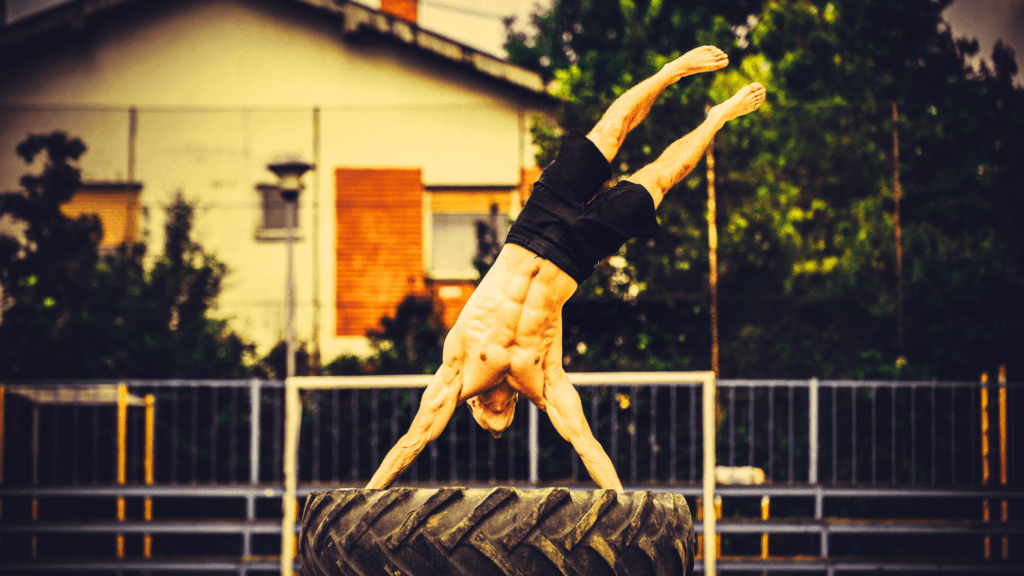
Dealing with Muscle Soreness
One of the most frequent issues beginners face is muscle soreness, particularly after starting a new workout routine. This soreness, known as Delayed Onset Muscle Soreness (DOMS), typically begins 24 to 48 hours after exercise and can vary from mild discomfort to more intense pain.
What is DOMS? DOMS is the result of tiny tears in your muscle fibers that occur when you perform exercises that are new or more intense than what your body is used to. While this soreness is a normal part of the muscle adaptation process, it can be uncomfortable.
Managing Muscle Soreness: Here are some practical tips to help manage and alleviate DOMS:
- Stay Active: Engage in low-intensity activities like walking or gentle stretching to help ease muscle stiffness and promote blood flow.
- Rest and Recovery: Allow adequate time between workouts for your muscles to recover. Quality sleep and proper rest are crucial for muscle repair and overall recovery.
- Hydrate and Eat Well: Drinking plenty of water and consuming a balanced diet rich in proteins and antioxidants supports muscle recovery and reduces inflammation.
- Use Heat or Cold Therapy: Apply a warm compress to relax tight muscles or use an ice pack to reduce inflammation and numb the sore area.
Staying Consistent
Maintaining consistency is vital for making progress with your workout plan. Here are some tips to help you stay committed to your fitness routine:
Set Achievable Goals: Establish clear, realistic goals for both the short term and long term. For example, you might aim to increase your number of push-ups or improve your plank duration over time. Having specific goals helps keep you focused and motivated.
Create a Routine: Stick to a regular workout schedule to build a habit. Choose specific days and times for your workouts and treat them as non-negotiable appointments. Consistency in your routine makes it easier to stay committed and integrate exercise into your lifestyle.
Find a Workout Buddy: Exercising with a friend or joining a fitness group can provide extra motivation and accountability. Having a workout partner can make the experience more enjoyable and help you stay on track.
Track Your Progress: Use a journal or fitness app to record your workouts, achievements, and any challenges you encounter. Keeping track of your progress helps you see improvements and stay motivated. Review your records regularly to adjust your goals and celebrate your successes.
Add Variety: Keep your workouts interesting by incorporating a variety of exercises and routines. This prevents boredom and keeps you engaged. Try different calisthenics movements or change the sequence of your exercises to maintain enthusiasm.
Adapting the Workout
As you progress, it’s important to adjust your workout routine to continue challenging yourself and address any limitations. Here’s how to adapt your workouts effectively:
Progressive Overload: Gradually increase the intensity of your workouts to continue making gains. This can involve adding more repetitions, extending exercise durations, or trying advanced variations. For example, if you’re comfortable with standard push-ups, you might progress to decline push-ups or incorporate clapping push-ups.
Modify Exercises: Adjust exercises based on your current fitness level or any limitations you may have. If a particular exercise is too difficult, start with a simpler variation and build up gradually. For instance, if you find standard push-ups challenging, begin with knee push-ups or wall push-ups and advance as you build strength.
Listen to Your Body: Pay attention to how your body responds during and after workouts. If you experience pain or discomfort, modify or replace the exercise to prevent injury. Incorporate rest days or active recovery as needed to allow for proper healing and avoid overtraining.
Incorporate Variety: Adding variety to your workouts helps address different fitness components and keeps you engaged. Include a mix of strength, endurance, and flexibility exercises to ensure a well-rounded routine. Alternating between different types of workouts can also prevent plateaus and promote continuous improvement.
Seek Professional Advice: If you’re unsure how to adapt your routine or need personalized guidance, consider consulting a fitness professional. They can provide expert recommendations tailored to your specific needs and help you make safe and effective adjustments.
In summary, effectively managing muscle soreness, maintaining consistency, and adapting your workout plan are crucial aspects of the best calisthenics workout for beginners. By understanding and addressing these common challenges, you’ll be better equipped to stay motivated, progress steadily, and achieve your fitness goals.
Nutrition Tips for Calisthenics Beginners
When pursuing the best calisthenics workout for beginners, nutrition plays a crucial role in maximizing your performance and aiding recovery. Proper nutrition not only fuels your workouts but also supports muscle repair, energy levels, and overall health. In this section, we’ll explore why nutrition is vital for your fitness journey, provide basic dietary guidelines, and discuss the importance of hydration.
Importance of Proper Nutrition
Good nutrition is fundamental to making the most out of your calisthenics routine. Your body needs the right nutrients to perform exercises effectively and recover properly. Without proper fuel, your workouts may suffer, and your recovery time could be extended.
Supporting Workout Performance and Recovery: Nutrition provides the energy required for intense workouts and the building blocks necessary for muscle repair. A well-balanced diet ensures that your body has the essential nutrients to support your fitness goals and enhance recovery.
Balanced Diet Essentials: To support the best calisthenics workout for beginners, focus on incorporating whole foods rich in proteins, carbohydrates, and healthy fats. These macronutrients are crucial for muscle repair, energy production, and overall health.
Basic Dietary Guidelines
A balanced diet supports both your performance and recovery during your calisthenics journey. Here are some simple guidelines to follow:
Macronutrient Intake:
- Proteins: Proteins are essential for muscle repair and growth. Aim to include a variety of protein sources in your diet, such as lean meats, fish, eggs, dairy products, beans, and legumes. A general guideline is to consume about 1.2 to 2.0 grams of protein per kilogram of body weight daily, depending on your activity level and fitness goals.
- Carbohydrates: Carbohydrates are your primary source of energy. For the best calisthenics workout for beginners, include complex carbs like whole grains, fruits, and vegetables in your diet. They provide sustained energy for your workouts and aid in muscle recovery. Aim for about 3 to 7 grams of carbohydrates per kilogram of body weight, depending on the intensity and frequency of your workouts.
- Healthy Fats: Healthy fats are crucial for overall health and hormone production. Incorporate sources like avocados, nuts, seeds, and olive oil. Healthy fats also help in the absorption of fat-soluble vitamins. About 20-35% of your total daily calories should come from healthy fats.

Nutritious Meals and Snacks: Here are some examples of meals and snacks that can support your calisthenics routine:
- Breakfast: A smoothie with spinach, banana, protein powder, and almond milk or an omelet with vegetables and whole-grain toast.
- Lunch: Grilled chicken salad with mixed greens, cherry tomatoes, avocado, and a vinaigrette dressing or a quinoa bowl with black beans, corn, bell peppers, and a lime dressing.
- Snack: Greek yogurt with berries and a sprinkle of nuts or apple slices with almond butter.
- Dinner: Baked salmon with sweet potato and steamed broccoli or a stir-fry with tofu, brown rice, and mixed vegetables.
Hydration
Staying hydrated is essential for optimal performance and recovery, especially when engaging in the best calisthenics workout for beginners. Proper hydration helps maintain performance levels, prevents cramps, and reduces fatigue.
Role of Hydration: Water supports many bodily functions, including temperature regulation, joint lubrication, and nutrient transport. Being well-hydrated enhances your ability to perform exercises effectively and recover faster.
Daily Water Intake Recommendations: Aim to drink at least 8 glasses (2 liters) of water per day. However, your needs may vary based on factors like exercise intensity, body size, and climate. If you’re engaging in intense workouts or sweating heavily, you might need more fluids.
Tips for Staying Hydrated:
- Carry a Water Bottle: Keep a reusable water bottle with you throughout the day to remind yourself to drink regularly.
- Consume Water-Rich Foods: Incorporate fruits and vegetables with high water content into your diet, such as cucumbers, oranges, and watermelon. These foods contribute to your overall fluid intake and provide additional nutrients.
- Monitor Hydration Levels: Pay attention to signs of dehydration, such as dark urine or excessive thirst. Adjust your fluid intake accordingly to maintain optimal hydration.
In conclusion, focusing on proper nutrition and hydration is essential for the best calisthenics workout for beginners. By following a balanced diet with the right macronutrients and staying well-hydrated, you can enhance your performance, support muscle recovery, and achieve your fitness goals more effectively.
Embracing the Best Calisthenics Workout for Beginners
As we wrap up our journey into the best calisthenics workout for beginners, it’s clear that embracing this form of exercise can be a transformative experience. By now, you understand the significant benefits of calisthenics, the importance of maintaining proper form, and the value of a consistent workout routine. Let’s take a moment to reflect on these key points and motivate you to take the next steps on your fitness journey.

Embrace the Power of Calisthenics
Calisthenics is more than just a workout—it’s a path to building strength, flexibility, and endurance using nothing but your own body weight. The beauty of calisthenics lies in its simplicity and accessibility. No matter where you are or what your fitness level, you can start with basic movements and gradually progress to more advanced exercises. The effectiveness of calisthenics stems from its ability to engage multiple muscle groups simultaneously, offering a full-body workout that enhances overall fitness and helps you achieve your goals.
Master Proper Form and Technique
One of the most critical aspects of the best calisthenics workout for beginners is ensuring that you perform each exercise with the correct form. Proper alignment and technique are essential for preventing injuries and maximizing the benefits of your workouts. By focusing on core engagement, posture, and breath control, you’ll not only perform exercises more effectively but also build a solid foundation for more advanced movements. Remember, it’s not about perfection—it’s about progress. Make small adjustments as needed and continually refine your technique.
Build Consistency and Enjoy the Process
Consistency is key to any successful fitness routine. Creating a structured plan, sticking to your workouts, and tracking your progress will help you stay motivated and committed. But beyond the routine, it’s important to find joy in the process. Celebrate your achievements, no matter how small, and recognize the hard work you’re putting in. Each workout is a step towards a stronger, healthier you. Be patient with yourself, listen to your body, and enjoy the journey of getting fitter.
Start Your Calisthenics Journey Today
There’s no better time than now to begin your calisthenics journey. Armed with the knowledge of how to structure your workouts, manage muscle soreness, and maintain proper nutrition, you’re well-equipped to start making progress. Dive into your routine with enthusiasm and a clear focus on your goals. Remember that every great achievement starts with a single step. Embrace the challenge, stay consistent, and trust in the process. Your dedication will pay off, and you’ll see the results of your hard work.
Engage with the Community and Seek Further Resources
Your journey doesn’t end here. I encourage you to share your experiences, ask questions, and connect with others who are also passionate about calisthenics. Leave comments or seek advice from those who have walked the path before you. Joining a fitness community can provide additional support and motivation as you progress. Also, explore additional resources or related articles to deepen your understanding and enhance your practice. Whether it’s advanced techniques, new workouts, or nutritional tips, there’s always more to learn and discover.
In conclusion, the best calisthenics workout for beginners is not just a fitness routine—it’s a gateway to achieving a healthier, stronger you. By committing to a structured plan, focusing on proper form, and maintaining consistency, you’re setting yourself up for success. Start today, embrace the process, and enjoy every step of your fitness journey. Your future self will thank you for the effort and dedication you put in now. Keep moving forward, stay motivated, and most importantly, have fun with your calisthenics practice.

